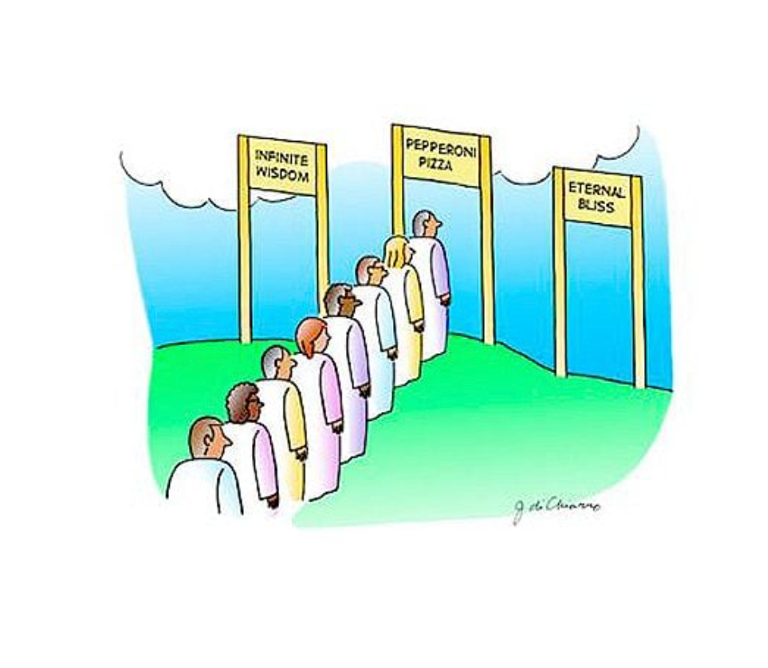Is Stagflation Coming?
Monthly Market and Economic Update – March 2023

Peter Flannery Financial Adviser CFP
“If you have one economist on your team,
it’s likely that you have one more than you’ll need.”
Warren Buffett
Key Points:
- Inflation appears to be moderating from the peak.
- But, recently The Producers Price Index (PPI) number came in higher than expected.
- Also, The Personal Consumption Expenditure Index came in higher than expected.
- Inflation remains elevated and ‘sticky’.
- Interest rates will need to rise further in the US, Europe, and New Zealand.
- The soft landing looks a bit less likely but is still possible.
THE MARKETS
What are business earnings telling us?
Quarterly earnings & revenue growth (year-over-year) – USA

The above graph tracks actual historical revenue (the orange bar) and earnings (the green bar) growth. It also shows earnings growth projections for the first, second and third quarters of 2023 (to the right of the graph).
Unsurprisingly, actual earnings over 2022 (4Q22 on the graph immediately above) have declined. Company revenues (top line / turnover) have generally slowed. The current outlook is for ongoing margin contraction and the slowdown in both revenue and earnings. This translates theoretically into lower trading prices.
However, it’s a question of how much of those projected earnings and revenue declines are already built into trading prices?
Not that I’m into predicting the future, but it would seem logical that if there are surprises either to the negative or the positive about earnings and revenue then we’ll see trading prices respond accordingly either way.
As far as the so-called bear market is concerned, we’re right in the midst of it now.
Total Annual Earnings – USA

The above graph tracks total earnings of the S&P 500.
The first graph above does not paint a rosy picture but needs to be taken into context with the second graph immediately above.
In the graph immediately above (Total annual earnings – USA), the 375.1 green bar above 4Q2020 (to the left of the graph) reflects the sharp drop in earnings as a result of COVID-19. Continuing across to the right you can see the sharp recovery in earnings over 2021 and then in 2022 earnings growth slowing significantly.
The point here is that it’s only to be expected when you look at how much earnings grew from 2020 through 2021. Those are hard growth numbers to beat.
It’s worth mentioning too that projections into 2023 are only projections. It is possible that they may or may not come in as good as the above chart shows.
The point here is that trading prices will rise and fall to reflect the market’s understanding / attitude about revenue and earnings direction.
Total earnings and earnings growth
It is useful to differentiate total earnings and earnings growth. Simply, total earnings are the dollar amount as shown on Total annual earnings – USA (the second graph above).
Earnings growth is the amount of growth on the dollar amount of earnings – see the Quarterly earnings & revenue growth (year-over-year) – USA (the first graph above).
Perhaps the other point worth reiterating is that whilst earnings growth has slowed materially, we can see at the same time that total earnings have more or less plateaued out when we step back with some perspective.
Let’s keep in mind that markets too are forward-looking.
The risk
I mentioned last month the risk of a 1970s-style stagflation environment.
To be clear though, decisions around investing are based predominantly on the characteristics of the business rather than the economic environment.
I mention stagflation here again though because, if by chance it did eventuate then those projections around earnings and revenue may look somewhat different across markets.
What’s important is that this doesn’t mean that quality businesses won’t still continue to grow, building wealth for us as investors. Investing across the markets though would prove challenging in that environment as distinct from investing inside the market like we do at WISEplanning. We can choose how we invest and where we invest.
I am watching the indicators around stagflation and so far, we appear to be heading for a soft landing, providing inflation numbers (month over month) out of the US continue to moderate. We have seen the annual inflation numbers across Europe and the UK remains stubbornly strong. I will keep you posted.
Silicon Valley Bank default
Silicon Valley Bank is America’s 16th largest bank. It defaulted a few days ago. Not good. Depositors at the bank became anxious and withdrew large sums which is the classic ‘run on funds’ that you can hear about in the media.
The US banking system is in a different place compared to the 2008 credit crunch. The banking system is sound and will be resilient, as this event unfolds. Although possible, it looks unlikely to spread across the broader banking system which is better capitalised as a result of the 2008 global credit crunch and the reforms implemented back then.
We will see trading prices decline sharply as the market reacts and works out what it means.
As one client mentioned, this is a possible disrupter for the market, and I watch with interest to see what opportunity emerges.
Currency
New Zealand dollar/US dollar currency cross rate

The above graph shows the movement in the cross rate over the last month.
As you can see from the graph above, we were getting close to the point where we were looking to take advantage of US dollar-based assets. However, the cross rate has slipped back down again which means that US dollar-based assets are slightly expensive at the moment. No problem though, we’ll simply wait and I will keep you posted.
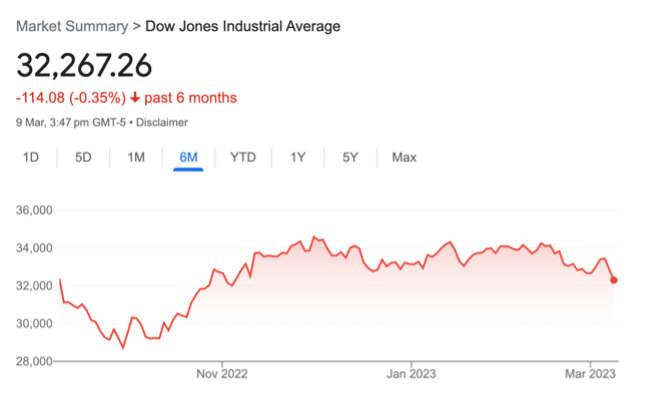
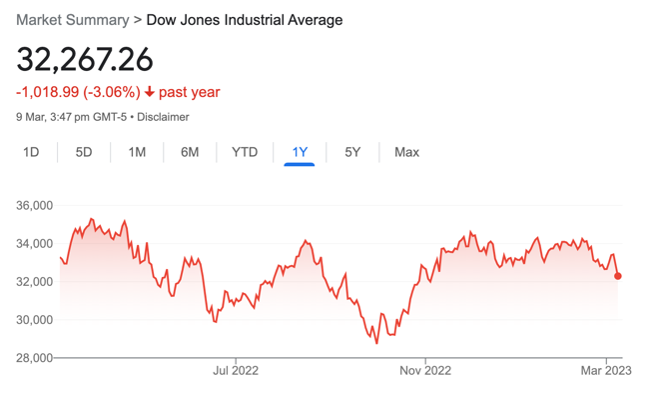
The chart on the left shows the US share market (the Dow Jones) over the last six months. The chart on the right shows the US share market (the Dow Jones) over the last year.
So, we can see that January saw an upswing in trading prices, whilst over February trading prices slipped back down again. No matter, what’s really important is that we’re investing in businesses that represent quality and therefore medium to long-term growth.
Last month we were musing about upcoming earnings announcements out of the US which have now mostly been completed with no real surprises.
Whilst earnings growth is currently negative and may continue to be so for a while longer, potentially over 2023, this doesn’t mean that markets won’t look through the negative earnings growth to what’s going on in 2024. After all we’re already a good way through the first quarter of 2023.
The Global Economy
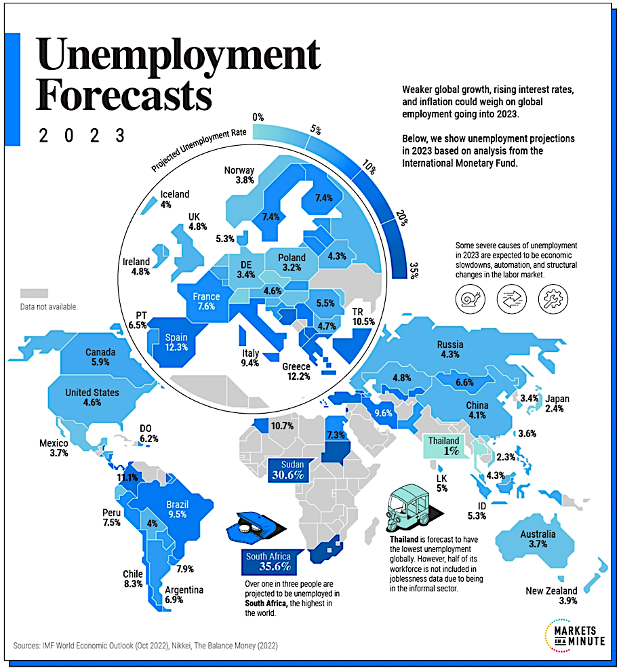
The above graph maps global projections for unemployment over 2023.
Global unemployment will likely rise over the next 12 months. Not ideal because it means that some people will be without jobs. That also means that economic growth may slow. More difficult times ahead for some as the impact of unemployment spreads.
Unemployment is scheduled to grow over 2023 in many countries because this is part of the recipe required to head off inflation. Low levels of unemployment mean lots of economic activity which can be inflationary.
The trouble with inflation is that it means small businesses and everyday citizens become squeezed as profits reduce and the take home pay simply doesn’t buy as much as it used to. There may be some discussion at home about the cost of some items at the supermarket.
New Zealand will be no exception as unemployment rises here too. Low unemployment in many countries remains stubbornly low, not helping central banks and their quest to get ahead of inflation.
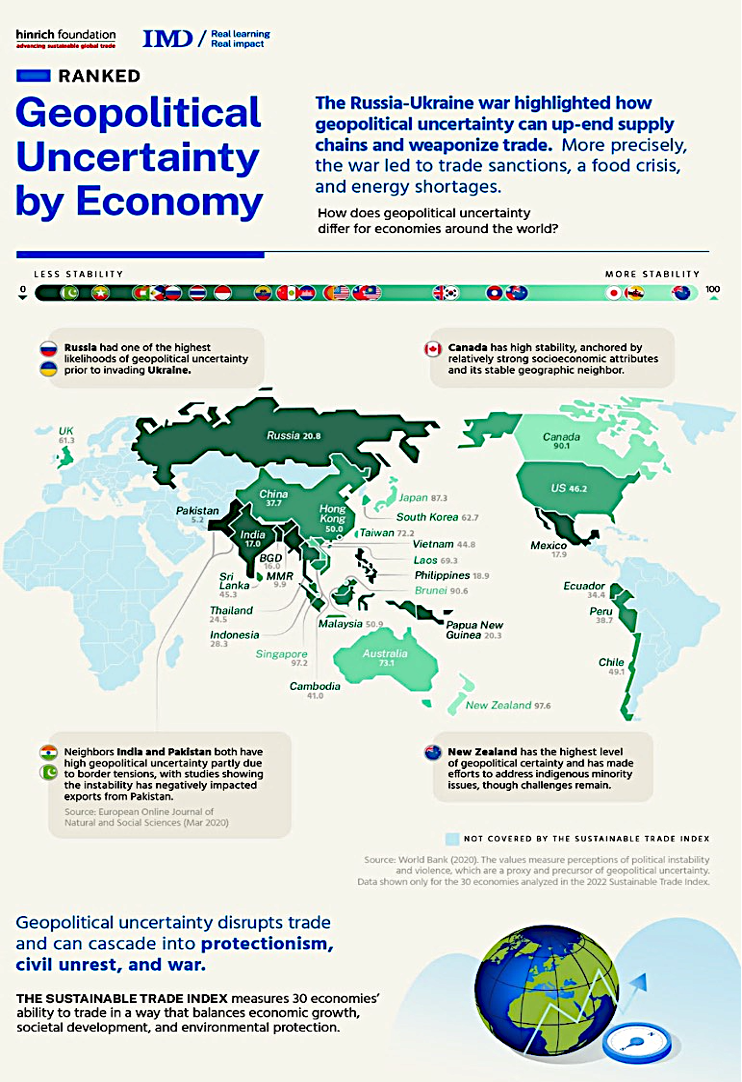
The above global map shows the level of geopolitical uncertainty in different countries around the world.
At the extreme end of geopolitical risk is countries “sleepwalking into war”.
There has been talk across the markets about this very issue, whether it be China potentially invading Taiwan or the Russia/Ukraine war turning into a more global event as larger players behind the scenes take sides.
Anyway, from an economic perspective, war can lead to trade sanctions, energy shortages and food shortages, as we’ve seen recently.
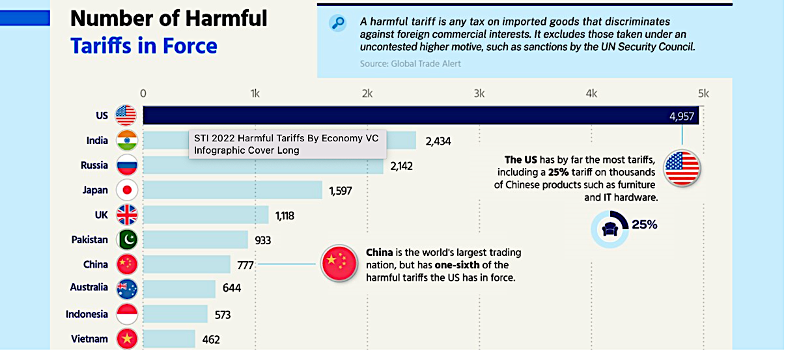
The above graph outlines the number of tariffs levied against various countries.
Interestingly, New Zealand has one of the highest levels of geopolitical stability, probably because we are a small country with no close neighbours directly.
America has moderate stability. It would appear that there’s been some increase in political polarisation in the US. This has led to people having lower trust in institutions for example.
America is still the world’s largest economy by some measures and also faces geopolitical risk such as potentially escalating tariffs between the US and China.
No surprises, however Russia has one of the lowest levels of stability.
So what does this all mean? Simply it’s part of the world that we live and invest in. It can impact strongly from time to time and be difficult to predict. Trends come and go.
It all forms part of the mix when thinking about the world in which we invest (the macroeconomic view as it were) and is a consideration that I take into account at WISEplanning, although predominantly our decisions around investing are based on the business that we are looking to buy.
The United States of America
The Personal Consumption Expenditure Index (PCE) – USA
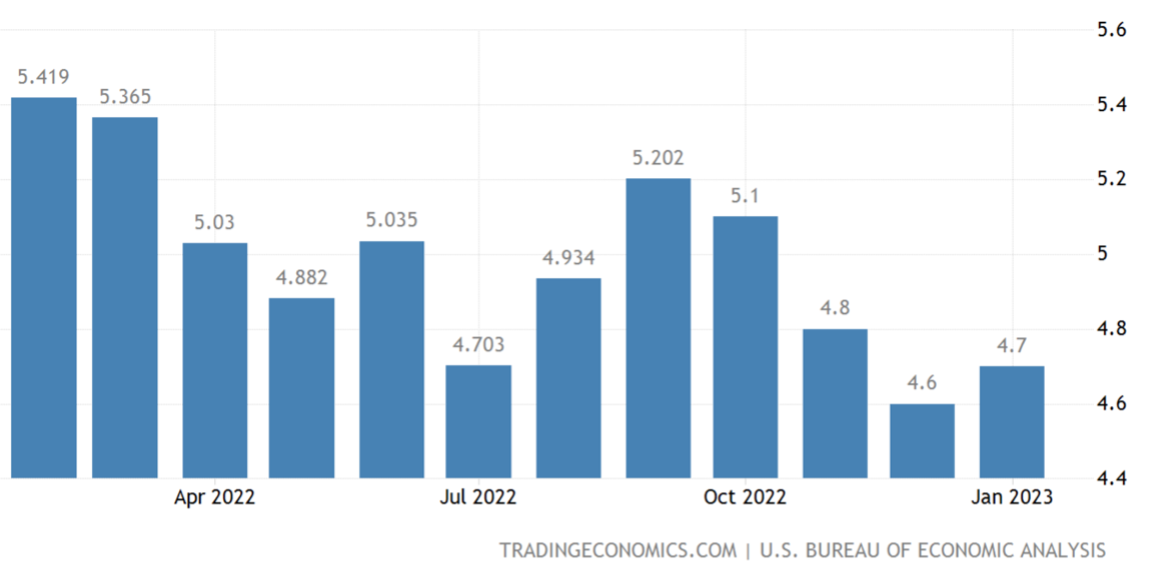
The above graph tracks the Personal Consumption Expenditure Index in America.
The above graph is a key indicator that the US Federal Reserve uses to gauge inflation direction and therefore how to consider interest rate adjustments in the US.
As you can see on the graph above, personal expenditure increased in January to 4.7% which is not ideal for the Federal Reserve and their efforts to curb inflation in America.
The Producer’s Price Index (PPI) – USA
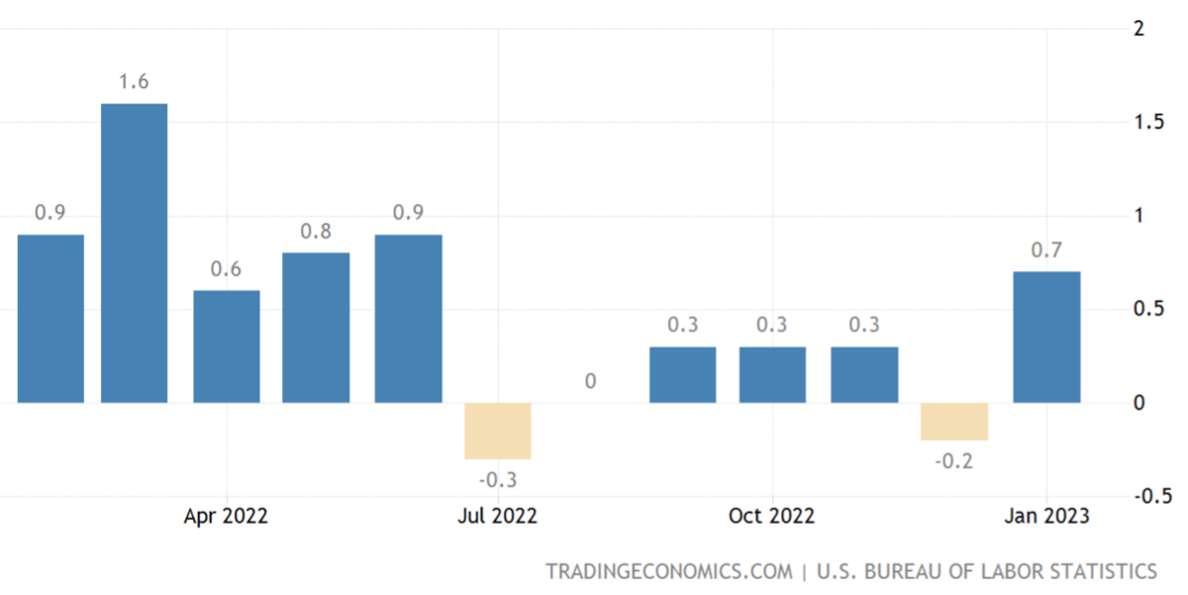
The above graph tracks a movement in the Producer’s Price Index in America.
Producer prices increased 0.7% month-over-month in January this year, the most in 7 months and higher than the market’s forecast of 0.4%.
I mention these two indicators because they are another headwind for the US Federal Reserve in their attempts to get ahead of inflation.
The two indicators above are reasonably significant although not enough to suggest that stagflation is gaining a foothold. These are indicators that I am watching.
Although we’ll wait and see, my expectation is that these indicators will subside. I look forward to the next reports due out soon and I will keep you updated.
As you know, this is all about inflation because that is a key driver of trading prices (of the businesses that you and I invest in) globally at the moment.
To me it’s less of an issue around where inflation sits over the next 2 or 3 months but more so about whether or not stagflation has a chance to get control of the global economy. At this stage I think not however I’m neither qualified nor equipped to predict the future.
Europe
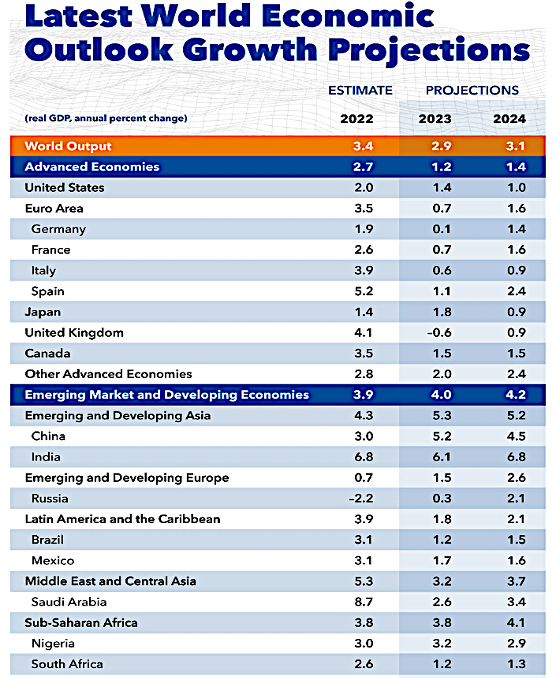
The above table outlines economic growth projections over 2023 and 2024. Specifically, take a look at the top box relating to Europe and the US and the United Kingdom.
Economic growth looks okay although fragile and thin.
As you can see, the projections above suggest that the United Kingdom may actually see its economy shrink over 2023. It’s worth noting that a 0.6% decline in economic activity doesn’t sound much but is significant in human terms across the economy and in economic terms as well. A small number but a material impact.
Germany is looking fragile also at 0.1% economic growth which is about as close as you can get to no economic growth without actually going there. This is important too because Germany is a large economy in Europe. So too are France and Italy.
Inflation outlook – Euro area and OECD
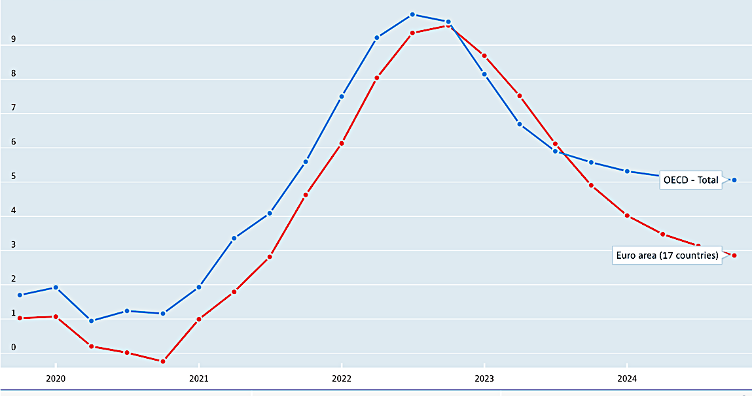
The above graph shows inflation rates in the past and projections into the future for the Euro area and the OECD.
Inflation as you can see from the graph above has tracked up to over 9% which is significant, particularly for a developed economy. It means further interest rate hikes ahead for Europe which of course is pain for everyday citizens and businesses.
The shape of the graph suggests declining inflation which may well take place although they are projections based on what we know at the moment.
Worst-case scenario is that inflation remains stubborn and stays higher for longer which equates to interest rates needing to continue to rise, possibly faster and stronger than the market has been expecting. Those interest rate rises have already been intense.
Best-case scenario is that the shape of that graph underestimates the pace of inflation moderation, and we see the soft landing materialise along with inflation being brought under control. Too early to tell just yet however at this stage stagflation is a less likely option…but data dependent.
China
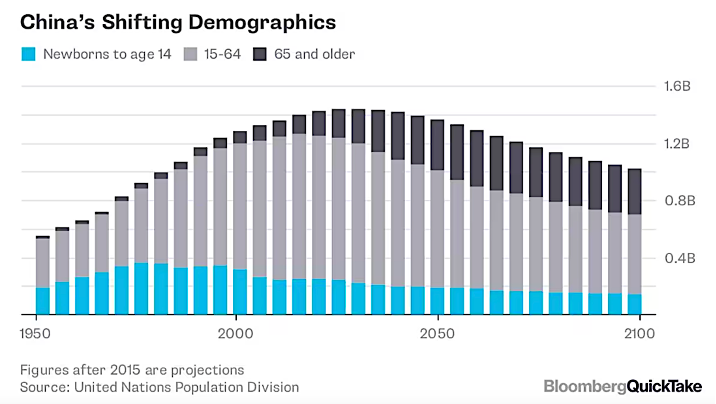
The above graph tracks China’s shifting population decline.
China’s population is in decline. I don’t believe this matters in the short-term and will have little impact on our investing initiatives currently.
Looking more medium-term however, there may be some headwinds created from a decline in population. That’s because an increasing population in some ways forms the baseline of capitalism. Greater and greater activity by more and more people generating more and more…
A declining population is arguably deflationary.

The above graph shows economic growth, historical data along with projections over 2023 and 2024.
Economic growth is moderating in China, which is understandable, particularly given the lockdown because of the Coronavirus pandemic. The lockdown was intense, and I’m surprised that economic growth was not affected more than the numbers show.
Anyway, they are projecting economic growth of around 5% over 2023 which is a good level of growth, particularly compared to most economies around the world.
As I have mentioned many times before, the Chinese government are very focused on economic growth because they need to maintain economic equilibrium and therefore stability across China. Not easy with an economy the size of China.
As an aside, there is some commentary suggesting that because of China’s emergence from the Coronavirus pandemic that this will help support economic activity globally. Good news on the one hand although not useful totally in terms of how that might impact on stabilising inflation in countries other than China.
China for its part whether by accident or by design has low inflation compared to the rest of the world – interesting.
Australia
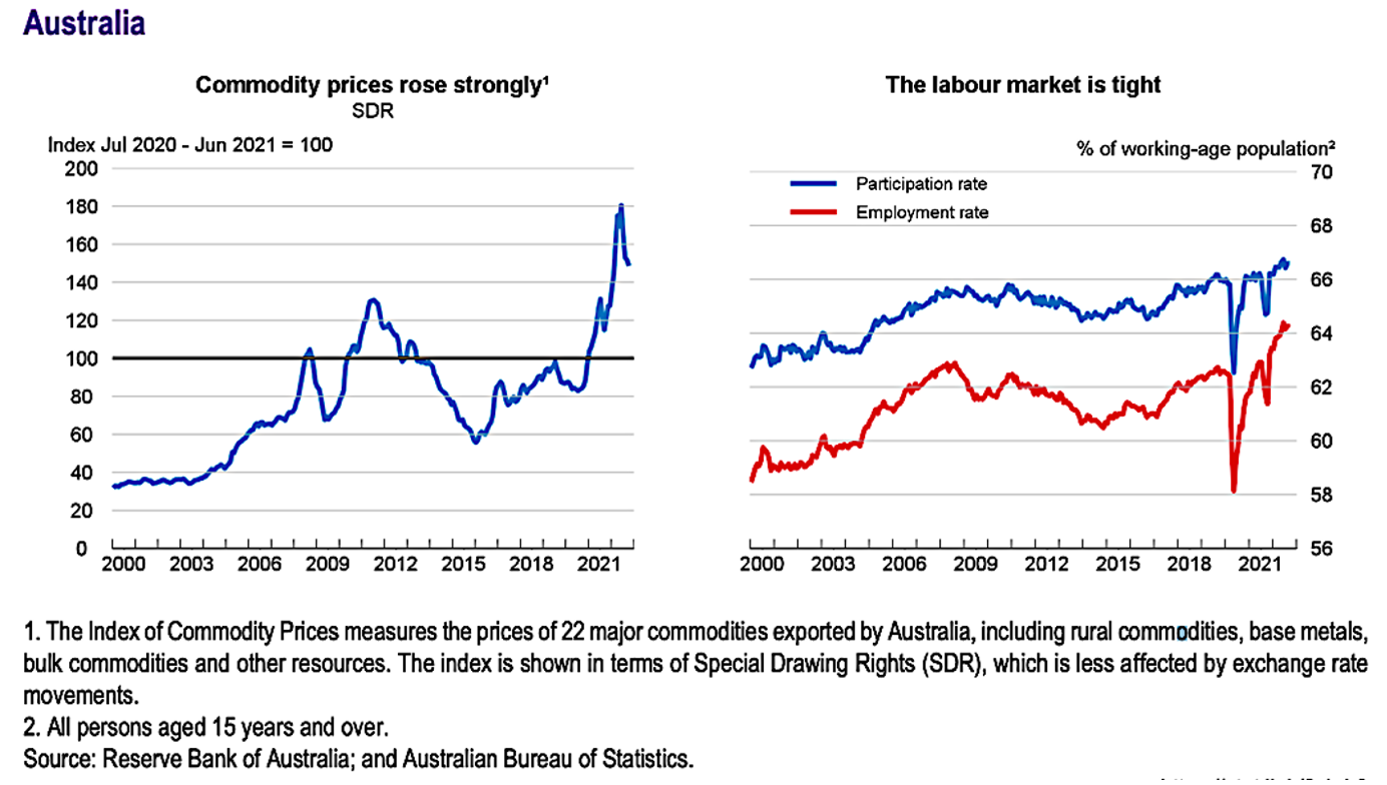
The graph to the left with the blue line spiking upwards and then declining sharply above 2021 shows the Commodity Price index in Australia. The graph to the right showing the blue line and the red line tracks employment participation and the employment rate.
The above graphs show that commodity prices may have peaked for now but at the same time employment remains strong in Australia, a headwind for getting inflation under control.
Commodity prices rising sharply is not untypical. That’s what goes on when demand jumps, and the market gets excited about quick profits made from commodities. It is after all a highly cyclical area of investment. It will be interesting to see where commodity prices move to next.
Employment in Australia remains low like many countries around the world. The participation rate by the way refers to the percentage of the population that is either working or actively looking for work.
Although I haven’t shown it here by way of a graph, I can report that the valuation of the Australian share market is reasonably fairly priced compared to other markets and represents modest value rather than being expensive like some other markets.
Although inflation is a problem in Australia, it is less of a problem compared to other areas of the world such as New Zealand, America and Europe.
Whilst it’s not plain sailing for the Australians, generally they are in not a bad situation overall from a market perspective and economically.
New Zealand
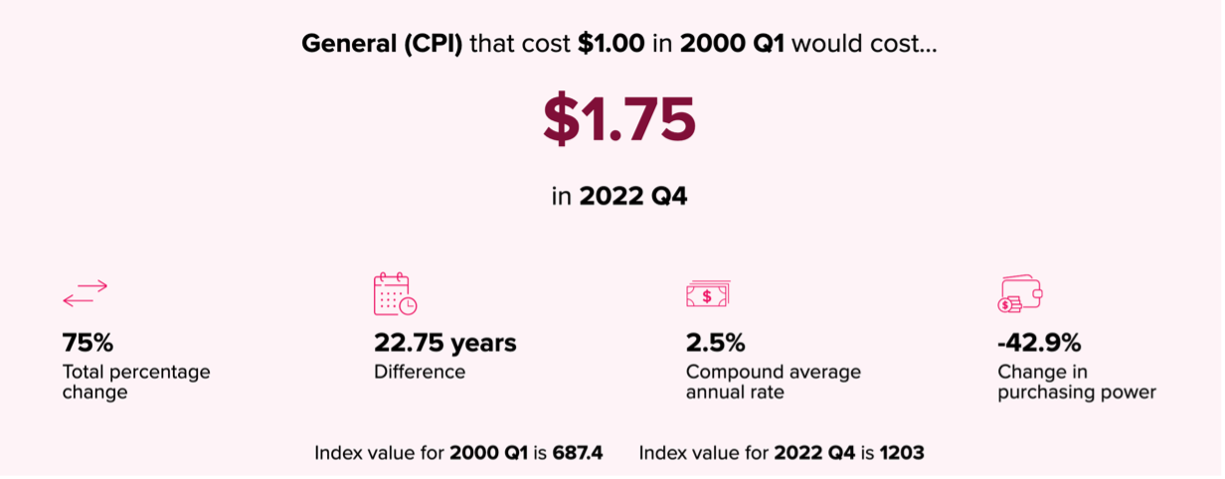
The above table shows what one dollar’s worth of goods or services cost in 2000 compared to now. $1 of costs in 2000 at the end of 2022 = $1.75.
As the above table shows, this is an average of 2.5% per annum over 22 years.
2.5%…is that a big number? Well of course if you’re an academic you will say compared to what?
Let’s look at 2.5% compared to 50 or 100%. In that case it is a small number.
2.5% of anything is a relatively small number until such time as we add it up over a period of time. When we do that, the accumulated total can mount up to a lot, even though the compounding rate, or the inflation rate in this case is only 2.5%.
That’s only an average. What about when you go to the supermarket? Do you notice the difference even after a period of just 6 months or 12 months?
The point about inflation is that it hurts some people more than others. In general terms it hurts those with less financial resources the most. Whether it be income they earn every month or week or the amount of capital they have invested and therefore the income that they derive from it.
Those most affected of course can be retirees who think they’re keeping their money safe by “investing” it in the bank. Of course, term deposits are generally a place to park capital. Not an investment.
Although long-term averages matter more than short-term numbers, if we look at the last 12 months (just to demonstrate the point) we can see that a 5% return on a term deposit after inflation of around 7% and deducting tax…well need I continue?
It’s a similar story for those earning low incomes to pay the bills each week who have little option. As the cost of goods and services rise, their income generally stays the same or rises at a rate that is slower than the increase in the cost of goods and services. This means that what they have to spend buys less and less.
Inflation is a problem. That’s why central banks raise interest rates so that unemployment rises and economic growth slows down in order to get ahead of that increasing cost of goods and services that hurt everyday people and businesses.
Residential property prices remain expensive in New Zealand
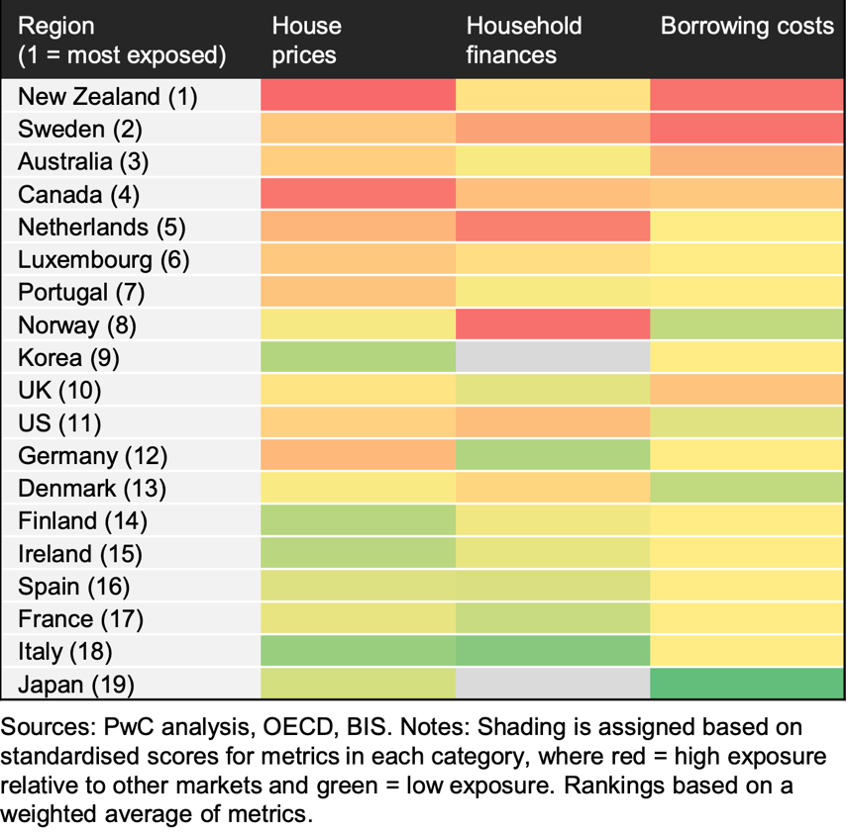
I know you read the above table last month. I think it tells a clear story about where things sit with the prices of residential property in New Zealand. The real point of it though is to think about where to next with residential property prices?
Of course, the market determines the price – not analysts, academics or financial advisers. Interest rates also help determine the level of residential property prices across New Zealand along with other items such as supply and demand and the general health of the economy.
To me, residential property still represents a worthwhile investment long-term. Like every other asset though, it is important that when we invest it is based on the economics of the property and the price we pay.
Residential property is not a good thing just because it is residential property. That’s how many have invested in the past due to the tailwinds of the liquidity bubble making residential property look like it was a “no-brainer”. Indeed, it was a good investment over 30 years or so. However we don’t invest in the past but rather the future.
It would appear that around 50% of mortgages in New Zealand will be rolled over at some point in the next 12 months or so.
Some will have low levels of debt and it will be a simple transaction – no problem. Others, may have purchased more recently and not only that, have high levels of debt.
Along with that goes high levels of debt servicing. Combine that with rising interest rates and there we have a problem for some.
The flow on effect may be that residential property prices strike headwinds in some parts of New Zealand over the next 12 to 24 months or so.
Still, it takes a lot to dent the confidence of an everyday Kiwi about the golden goose called residential property.
The problem is that we don’t invest in idealistic notions but rather the reality of the economics of the asset and therefore the pricing of the property.
At this stage though there does not appear to be a residential property price ‘crash’ in sight although property prices are generally declining. Anyway, the banks won’t want that. Neither will the politicians or anyone else (apart from savvy investors that is).
Inflation remains relatively strong in New Zealand and therefore expect further interest rate rises.
Elections in New Zealand are looming…
In Summary
Global inflation remains annoyingly persistent as we’ve seen across Europe and America.
China does not have an inflation problem although they may have a population growth issue in the future. Right now though they are in a reasonably stable position. As the Chinese economy continues to open up, emerging from the Coronavirus pandemic lockdowns, this may support global economic growth but also underpin global inflation to some degree.
Speaking of which, global economic growth is sluggish which is an indication of the risk of stagflation taking hold potentially. We’ll need unemployment to rise and interest rates to rise more.
Stagflation is a contingent risk in my view. No need to lose sleep over it yet however I am keeping an eye on it.
As I mentioned last month, with regards to the markets, “choppy sideways” is underway.
I expect we’ll be tired of that phrase and the repetitive nature of it over 2023.
No matter, the underlying businesses that have quality earnings may well be growing despite the movement in the trading price.
We can see this with a number of businesses in which you are currently invested. Earnings might be under pressure although in some cases revenue (turnover) continues to rise. This means the business is continuing to grow. We just need to be careful not to place undue emphasis on the trading price which is determined by little more at times than the mood of the market from one month to the next.
The Silicon Valley Bank default is scary for the markets. That’s why we see sharp trading price declines. This underpins the importance of investing in quality businesses.
Economic conditions are not ideal. There will be more ‘pain’ ahead. Still, New Zealand is doing okay. Generally, the global economy is doing okay, at least as far as developed economies go (no, the global economy has not crashed and burned. It can be wise to be selective about what and who you listen to).
Interest rates have increased at pace around the world which may help to head off inflation. If that is the case, then expect the markets to see that early.
Meantime let’s continue nibbling away on well selected opportunities as pricing allows.
